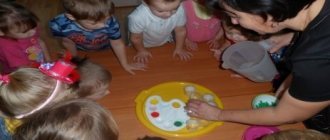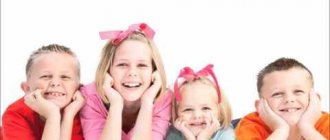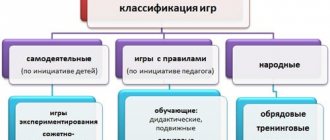MAGAZINE Preschooler.RF
COGNITIVE - RESEARCH ACTIVITIES IN DECREATIONAL IU IN THE CONDITIONS OF IMPLEMENTATION OF THE FSESBabynina T.N., Burmitskaya N.N., Moroz E.A. MDOU "Combined kindergarten No. 19, Razumnoye village, Belgorod district"
“The best discovery is the one that a child makes himself . Ralph W. Emerson.
The cognitive research activities of children in kindergarten are invaluable for the development of the personality of a preschooler. This type of activity is important and one of the leading ones. It is through exploration that children learn about the world around them and acquire new knowledge. Cognitive research activities are necessary in every age period of a preschooler. In different age groups, according to the principle of using age-appropriate types of children's activities, this can be observation, experimentation, targeted walks, excursions, and various problem situations.
Preschool children are by nature inquisitive explorers of the world around them. “It’s better to test it once, try it, do it yourself ,” practice teachers say.
The work of a teacher, based on the Federal State Educational Standard (FSES), should be aimed at developing cognitive activity and research skills in children. In accordance with the requirements of the Federal State Educational Standard, kindergarten teachers need to organize situations that provoke the cognitive activity of pupils. One of the forms of such influence is experimental research activities in preschool educational institutions.
In the process of mastering methods of practical interaction with the environment, children transform objects in order to reveal their hidden significant connections with natural phenomena. Knowledge of the surrounding world as a whole is impossible without knowledge of nature. Studying problems to become familiar with natural phenomena is a means of mental, aesthetic education.
Cognitive research activity is not only to facilitate children’s assimilation of specific information about plants, animals, natural phenomena, to instill in them environmental skills and respect for the natural world and the environment, but also allows the child to develop qualitatively. Younger preschoolers, with the help of an adult, and older ones independently go in search of knowledge, are interested in everything new, unknown, ask adults a lot of questions, make guesses, reason, think, look for different ways to solve problem situations, experiment, rejoice and be surprised by their own discoveries.
Psychologists emphasize that for a child’s development, it is not the excess of knowledge that is crucial, but the method of acquiring it, determined by the type of activity in which this knowledge is acquired. Conducting experiments and organizing experimentation is one of the effective ways to educate preschoolers’ ecological culture. Research provides the child with the opportunity to find answers to the questions “how?” and why?" .
One of the general tasks of the kindergarten is to work on developing ideas about cause-and-effect relationships through experimental activities in nature, taking into account the regional component, using innovative programs and methods, as well as modern forms of education.
Research activities are of great interest to children. The practical actions performed by the child develop the cognitive, tentatively research function, creating conditions for revealing the content of a given object, and therefore knowledge about cause-and-effect relationships is formed. This type of activity has a positive effect on the emotional sphere of the child; to develop creative potential, to improve health by increasing the level of physical activity. In the process of cognitive research activities, children have the opportunity to realize their characteristic curiosity, to imagine themselves as a scientist, researcher, discoverer. At the same time, the teacher is not a mentor, but becomes a playing partner in joint activities, and this allows the child to show his own research activity.
In the process of children's experimentation, kids learn: to find and identify a problem, to accept and set a goal, to solve problems, to analyze an object or phenomenon, to identify essential features and connections, to compare various facts, to put forward hypotheses, proposals, to choose the means and materials necessary to carry out this activity, carry out an experiment and draw conclusions. Children experience great delight and surprise from their small and large “discoveries ,” which make them feel proud of the work they have done. In the course of such work, preschoolers are better and faster able to find a way out of difficult situations and cope more easily with the problems that arise.
In the process of research activities, the child gains experience:
- Physical: learns to control your body and certain organs.
- Natural history: gets acquainted with the real world around us, with the properties of objects and cause-and-effect relationships operating in the world.
- Social: remember the individual characteristics of each person.
- Cognitive: train thought processes, master a variety of mental operations.
- Linguistic: engage in word creation, discuss the results of the experiment, play word games, that is, experiment with words.
- Strong-willed: remember how he himself can influence people.
- Personal: recognize your personal capabilities.
- Behavioral: model your behavior in various situations.
Children's cognitive activity should be ensured through the use of methods of observation of natural objects and natural phenomena, game modeling and experimentation, problem-game situations, work in nature, and viewing illustrations. It is important that the methods used correspond to the interests of children, their cognitive abilities, and the characteristics of their attitude towards the environment.
The organization of a developmental environment is one of the conditions for solving the problems of research activities in kindergarten. “An experiment or experience is a special type of observation organized in specially created conditions” A.I. Vasilyev, and therefore each kindergarten group is equipped with “mini-laboratories” for experimentation, where children can independently and with the help of an adult reproduce simple and more complex experiments. The laboratory was created to develop children's interest in research activities, where the development of primary natural science concepts, observation, and curiosity occurs.
The laboratory is constantly updated with new materials for experimentation, which are in a place accessible to children.
Depending on the age of the children, the Experimentation Center may contain:
- Various instruments: scales, magnifying glasses, magnets, microscopes, magnifying glasses;
- A variety of vessels made from various materials
- Natural materials: leaves, sand, clay, earth, seeds;
- Nuts, paper clips, screws, nails, wire;
- Medical materials: pipettes, flasks, syringes, measuring spoons, cotton wool, bandage;
- Waste material: plastic, pieces of fabric, leather, fur;
- Flour, salt, soda, candles, lanterns;
- Children's robes, aprons;
- Schemes-algorithms for conducting experiments;
- Journal for recording results, etc.
In the process of cognitive research activities, the teacher encourages children to independently accept and set cognitive tasks, put forward proposals about the causes and results of observed natural phenomena, notice contradictions in judgments, and use different ways to verify proposals; trial and error method, experiments, comparative observations. Teachers take into account children’s preferences for learning about various natural objects, are interested in who or what they would like to learn about, and are attentive to children’s questions. They support preschoolers' interest in nature, observation, experimentation, and studying materials from encyclopedias and magazines. They stimulate the manifestation of children's curiosity, the desire to study natural phenomena more deeply, using the basic methods of cognition.
Thus:
- Experimental activities help make communication with children more trusting and friendly; it encourages them to engage in independent research and active learning.
- Children's experimentation, as a method in pedagogical work, is highly effective and indispensable for the development of preschoolers' research activities, cognitive activity, and increasing the amount of knowledge, skills and abilities.
List of used literature:
- Dybina O. V. “Classes on familiarization with the outside world in the second junior group of kindergarten” M.: Mozaika - Synthesis, 2007 (methodological manual).
- Nikolaeva S. N. “Methods of environmental education in kindergarten . – M. 1999.
- Odintsova L. Experimental activities in preschool educational institutions. Toolkit. – M.: Sfera, 2012.
| Next > |
Organization of educational and research activities in preschool educational institutions
All the guys are interested in everything in the world,
Because why are inquisitive children
And they bring their why questions to kindergarten,
Because the teacher will be happy to answer them.
* * *
Currently, the latest developments, technologies, and methods are being formed and successfully applied in the preschool education system, which make it possible to raise the level of preschool education to a higher and higher quality level. One of such effective methods of understanding the patterns and phenomena of the surrounding world is cognitive research activity .
The theoretical basis of the work was the research of Academician Nikolai Nikolaevich Poddyakov, Doctor of Pedagogical Sciences Olga Vitalievna Dybina, Raisa Mikhailovna Chumicheva, which helped to clarify the essence of children's experimentation as a form of search activity , its structure and significance in the development of the child’s personality. N. N. Poddyakov claims that children's experimentation claims to be the leading activity during the period of preschool development of the child. Its main proof is the fact that the activity of experimentation permeates all spheres of children's life, including play, which arises much later than the activity of experimentation and is built by the children themselves, which contributes to their self-development.
So, the key word was sounded - experiment. What is necessary for its successful organization . Our experiment is based on three main components, “three pillars”
.
The first component answers the question “Who?”
.
Dear colleagues, who is needed to organize educational and research activities ? Of course it's a child. After all, educational and research activities for children are a door to a magical land of the unknown , where there are mysteries and, most importantly, new discoveries are hidden behind every riddle.
So, what’s next, and then we need “scenery”
.
The question here is “What?”
and the second integral component of experimental detail appears - this is...equipment. It must be safe, universal and accessible to use.
And now my children and I are ready to completely immerse ourselves in science, in search of answers to a variety of questions.
Video
- Why do you need ears? - the teacher asks the girl.
- To see everything.
Of course, from the height of his life experience, the teacher immediately wants to correct the mistake and give the child a ready-made correct answer to the question. In the field of exact sciences, we think this would be the correct model of behavior, but if we consider cognitive and research activities in kindergarten, the key to success here lies elsewhere. We do not break the thread of reasoning, but rather cling to it. And we come to the third component – the object of research. The most important question should be asked here... What do you think is the key question in the field of cognition ? Any suggestions? Right, WHY? Let's ask this question together to our girl Polina, three or four... WHY! Indeed, why ears, because that’s what eyes are for!
Video
- So that’s how it is... But if there are no ears, then the hat will slide over my eyes, and I won’t see anything.
It is necessary to understand the main thing: the consciousness of a preschool child is free from stereotypes. It is quite natural that preschool children have little knowledge of what science with a capital S is, however, they, like no one else in the world, are able to look at seemingly ordinary things from a completely new angle. It is at this moment that we provide the child with the opportunity to test his guesses in practice - this will be the best answer to all the children’s whys.
Children study, and we observe and think. Often the idea of experimental activity is very superficial ; many people imagine “that something should be bubbling, smoking, or at least bubbling”
.
We once thought so too. Chemistry can explain many phenomena in our lives and it is not at all necessary that “something just smokes
. So it is with experiments. What is important is not the spectacularity of the action taking place, but the meaning of the work done and the correctly formulated conclusion. It is very important that it is adapted for children's consciousness. Should the child understand what he is doing? what is he doing for? and what he finally found out!
The relevance of our chosen topic is confirmed by the fact that on the basis of the Kommunarsky kindergarten “Solnyshko”
There is a municipal experimental site on the topic: “Environmental education of preschool children through the introduction of research technology
. ”
The goal of our work is to create conditions for the development of children’s cognitive activity , curiosity, the need for children’s mental impressions, the desire for independent knowledge and reflection .
The goal identified the following tasks:
— expand children’s understanding of the world around them through familiarization with basic physical properties and phenomena;
- develop coherent speech, encourage reasoning, argumentation, use speech - evidence;
- involve parents in joint experimentation activities
The integrity of cognitive and research activities is based on the complex principle of building continuity of the process and provides for the solution of program problems in the joint activities of the teacher , children and parents.
Expediency. Cognitive and research activities contribute to the full enjoyment of preschool childhood, allow individualization of the pedagogical process, and immerse the child in an atmosphere of creativity, independence and initiative.
Creation. Cognitive and research activities in kindergarten can be organized by teachers in the form of observations, practical experiments with elements of experimentation, play activity, collecting, designing, and this list is not complete, so preschool teachers can safely implement a creative search in the direction, carefully monitoring reactions and children's level of interest.
Let's consider the technology of experimentation through the prism of educational areas of the Federal State Educational Standard for Preschool Education:
SOCIAL-COMMUNICATION DEVELOPMENT
(interaction with peers and adults. For a successful experiment, everyone needs to agree on the upcoming work and distribute responsibilities.)
COGNITIVE DEVELOPMENT (development of imagination and creative activity, there is a need to perform operations of analysis and synthesis, comparison and classification.)
SPEECH DEVELOPMENT (enrichment of active vocabulary. There is a need to tell others about your new experience, about what you saw.)
ARTISTIC AND AESTHETIC DEVELOPMENT (experiments and experiments involve the implementation of independent creative activities of children - visual, constructive and model.)
PHYSICAL DEVELOPMENT (children improve physical qualities such as coordination and coordination of movements, develop large and fine motor skills.)
The implementation of this technology involves the use of research and activity approaches .
The research approach underlies learning, in which the child is placed in a situation where he himself masters the concepts and approach to solving problems in the process of cognition , to a greater or lesser extent, organized by the teacher .
The activity approach explains the process of active research assimilation of social experience through motivational, goal-oriented problem solving. This activity is not set by adults in advance in the form of one scheme or another; it is built by the preschooler himself as he receives new information about the object.
Based on the research of Olga Vitalievna Dybina and Raisa Mikhailovna Chumicheva, conceptual principles were substantiated that ensure the effectiveness of the implementation of children's experimentation technology:
-stimulating the experimental activity of a preschooler . The stimulating factors are the situation of choice, the problem.
-The principle of freedom and independence. Providing the child with an independent determination of attitude towards the environment, independent research, choice of goals and application of the result.
-The principle of activity. Allows children to recreate adult forms of activity (experiment, experience)
.
At the first stage of working with children, children’s ideas about the properties and qualities of materials were clarified, we introduced children to some phenomena and objects of inanimate and living nature, preschoolers were involved in the transformation of problem situations, and their interest in experimentation was stimulated. When interacting with the child, the process was structured as follows: knowledge was not communicated in a ready-made form, but assistance was provided to the child in obtaining it independently. Having carried out a small experiment, the child thought through the stages of its implementation, and together with him the necessary actions were carried out. Gradually, they began to involve children in predicting the results of their actions: “What will happen if we blow on a dandelion?”
. At this stage, children began to practically master the properties and qualities of various materials, children actively participated in the study and transformation of various problem situations, and became familiar with ways to record the results obtained.
We used the following problem situations: “Let’s find out what kind of water it is?”
,
“Where did the water go?”
,
“Where does water come from?”
,
“What properties?”
,
“To see the air you need to catch it,”
etc.
During the activity, children were helped to identify the sequence of actions and reflect them in speech when answering the questions: What did we do? What did we get? Why?. The assumptions and results of the experiment were compared, and conclusions were drawn based on guiding questions: What were we thinking? What happened? Why? The children learned to find similarities and differences between objects. At the end of the experiments, we discussed with the children which of them had learned something new.
Children actively participated in the proposed experiments, willingly acted independently with objects, identifying their features (for example, the ability of a magnifying glass to “enlarge”
and
“shrink”
objects, etc.). They showed a desire to experiment at home: to study various household items, their effects (they froze water in the refrigerator, put ice on the radiator, etc., this was clarified in conversations with parents and children. We also conduct experiments with plants:
“In what conditions does onion grow best?” “Growing seeds in and without water,”
etc.
Effectiveness. At this stage of work on the stated topic, we can talk about intermediate results:
-experimental research activities arouse great interest among children,
-helps the child experiment and synthesize acquired knowledge;
- build a relationship between the teacher, parents, and children of the group based on partnership;
-develop creativity, communication and cognitive skills .
To form the cognitive activity of children in kindergarten, the following conditions were created:
-organization of a subject-spatial development environment: card files of experiments and experiences, a corner “Young Scientist”
,
“Ecological Corner”
, the library has been replenished with encyclopedic literature;
-involvement of parents: performing experiments at home.
The knowledge and skills obtained as a result of one’s own experimental search are much stronger and more reliable than those obtained through reproductive means.
Encouraging children's curiosity, quenching the thirst for knowledge of little “whys”
By directing their
cognitive activity into experimental activities, we contribute to knowledge of the world around us , awareness of its diversity and help determine their own place in it.
In conclusion, I would like to note that experimental activities also solve such an important problem as continuity between preschool education and school. After all, the level of cognitive activity of children is a necessary component of educational activity . And the knowledge and skills children acquired in the field of experimentation will be relevant and in demand during training and are certainly the key to high achievements of my students in the future.






